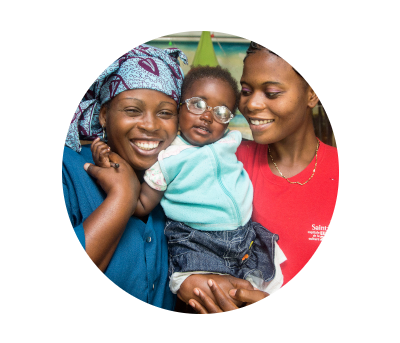BREAKING THE VICIOUS CIRCLE
In developing countries, blindness has an impact on the whole family. A blind person cannot participate in everyday life or contribute to the family’s income. Often children or grandchildren have to take care of their blind parent or grandparent, meaning that they cannot go to school.
Disabilities are often the result of fear and superstition, a lack of information, poor hygiene and a shortage of specialized medical personnel and infrastructure
There is also a strong link between disability and poverty: a person who is poor has little or no access to health care and is therefore more prone to disabilities. That is why we talk about being “unnecessarily blind”. A person with a disability usually lives on the margins of society, has no job and is often rejected by his or her family. Moreover, barely ten percent of children with a disability attend school.
With the support of local partners, experts, donors and business partners, Light for the World has been breaking this vicious circle for more than 20 years. We improve access to health care and help people with a visual impairment to integrate into society. Together we offer them a better future.

EYE CARE FOR ALL
Eye care does not only include surgeries. We believe in a global and sustainable approach to fight blindness efficiently.
We make eye care accessible on the spot. Community workers seek children and adults with a visual impairment and raise community awareness. We make quality medical equipment available to eye clinics. We provide intensive training to local medical and administratif staff, who take care of surgical treatment and medication, as well as visual therapy. All eye clinics that we support have set up an optical store, which sells manufactured onsite glasses at affordable prices.
EVERY CHILD HAS A RIGHT TO EDUCATION
In developing countries, only 10 % of children with a visual impairment go to school. Light for the World supports education programmes for blind and visually impaired children.
Our education programmes are aimed at inclusive education. Visual therapists optimalise visually impaired children’s residual sight. These children also benefit from an suitable infrastructure and adapted visual aids, such as a magnifying glass or a telescope. Blind children are given a special training for a few years to learn Braille, amongst other things.
Subsequently, we try to integrate most of these children in their neighbourhood school where they follow classes with children of the same age. Specialised teachers mentor pupils and their parents, as well as their teachers. All these measures will make their integration easier and put an end to their disability stigma.


OUR PROJECTS
Congo:
- Saint Yvonne Eye Clinic in Lubumbashi
- Inclusive education programme in Lubumbashi
- Nuru Institute for blind and visually impaired children in Lubumbashi
- Saint Joseph Eye Clinic in Likasi
- Saint Raphael Eye Clinic in Mbuji-Mayi
- Mwangaza Eye Clinic in Kolwezi
- Mulami Muimpe Eye Clinic in Kananga
Rwanda:
- Kabgayi Eye Unit in Gitarama
- Inclusive education programme
- HVP Gatagara School for blind and visually impaired children in Rwamagana
Tanzania:
- CCBRT Eye Unit, Comprehensive Community Based Rehabilitation Tanzania in Dar es Salam
- KCMC Eye Unit, Kilimanjaro Christian Medical Centre in Moshi
- SFRH Eye Unit, Saint Francis Referral Hospital in Ifakara
- SJMH Eye Unit, Saint Joseph’s Mission Hospital Peramiho in Songea
- BMH Eye Unit, Benjamin Mkapa Hospital in Dodoma
- MRRH Eye Unit, Morogoro Regional Referral Hospital in Morogoro
- Inclusive education programme
- Early detection programme
OUR NUMBERS
ANNUAL RESULTS 2023

12
eye clinics

280960
consultations

22198
surgeries

12633
cataract surgeries

30323
pairs of glasses

1618
children go to school

Give access to education
With 11 euro a child with a visual impairment like Agnes can go to school for a month.

Give sight to an adult
With 52 euros you offer cataract surgery to an adult like Melanie.

Give sight to a child
With 150 euro, you can restore the sight of a child like Saidi through cataract surgery under general anaesthesia.
